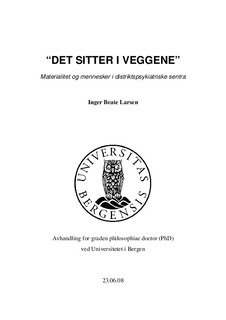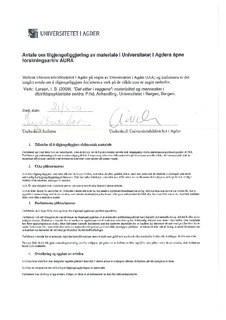| dc.description.abstract | ABSTRACT
Title: “IT’S EMBEDDED IN THE WALLS”
-Materiality and people in district psychiatric centres
This dissertation examines the impact that the materiality of institutions has on
patients and staff. Fieldwork has been carried out at five district psychiatric centres
(Distriktspsykiatriske sentra, DPS) that were originally built as tuberculosis
institutions. The patients’ and employees’ experiences of being present in the physical
and social space of these institutions has been examined, interpreted and reflected
upon. The paper provides knowledge about the significance institutions’ materiality
and inner life has on the informants, and how the informants influence the materiality.
Background
Mental health care has moved away from institutions and towards the local
community. The treatment district psychiatric centres offer is limited to short term
stays. Norwegian health policy stresses the user’s perspective and the coping
perspective as necessary preconditions for undergoing change. At the same time the
need for specialist training is emphasized. On the one hand there is a wish for a
transformation that requires change in the understanding, recognition and treatment of
persons with mental health problems. On the other hand the wish for further
specialization and closer commitment to existing medical standards is highlighted.
This implies an ambiguity that is both distancing itself from the belief that specialists
know the patients’ needs best, parallel with maintaining the role and importance of
the expert. The role of today’s institutions for the mentally ill within this ambiguous
picture is thus an underlying issue in my discussion. The primary aim of the
dissertation is to contribute to building knowledge of the reciprocity and interaction
between materiality and people within mental health care. At the same time the
research will show that an institution does not exist independently of its history,
including the health policies and knowledge that prevailed when the institutions were
formed.
Theory
The theoretical starting point of the dissertation is the work of the Norwegian
architect Christian Norberg-Schulz, and that of the French historian, philosopher and
epistemologist Michel Foucault. The former represents a phenomenological approach
to the link between the importance of public places and people’s self-awareness.
Foucault looks at different institutions’ material, mental and social space as
representational of the power- and knowledge relationship. This relationship makes
patients and employees both disciplined by others and self-disciplined.
Methodology
The dissertation is grounded in a reflective research tradition referred to as ‘multisited
fieldwork’. Data has been gathered through participant observation in five DPS. The
observations led to different approaches and sources like interviews, photography and
documentary analysis. These sources provided information about today’s practice
within mental health care, in addition to insights into the practices of tuberculosis
treatment in the first half of the 20th century. The analysis of the data involves
repetitive text analysis. This resulted in identification of the following key themes
addressing the relation between people and materiality, here entitled: 1) “To get away
to recover,” 2) “To feel at home on the way home,” 3) “History in novelty,” and 4)
“The obvious medication.” The interpretation has moved from looking closely at
phenomena to abstraction. This demonstrates that DPS’ are parts of an extended
context relating to history and politics.
Findings
The research confirms that institutions affect people’s lived experiences to a
considerable extent. In relation to the patients, institutions become places attracting
them when they are ill. Location and materiality shield and protect them from the
outside world. This research demonstrates that patients think rest is an important part
of their recovery process. Small rooms and homelike atmospheres contribute to
relaxation and recovering. Conditions relating to consideration and caring comprise
what encourages health.
In relation to the employees, institutions become places where they can adjust to a
new and active treatment ideology. ‘New’ is interpreted as a further specialization
within the medical perspective. The employees use the rooms as a way of
distinguishing themselves from the patients. They work towards disposing of the
traditions from the era of tuberculosis. The research shows that employees’
understanding of ‘active treatment’ is in conflict with the patients’ need for rest in
homelike atmospheres.
Other key findings show that the institutions represent an authoritarian understanding
of mental problems as illnesses. This understanding of illness is related to the view of
contagious illnesses in the early 20th century. This view seems to be ingrained in
today’s institutions. Remote locations, guardrooms, and medicine dosage systems are
important elements that support this view. This shows that the understanding,
recognition and treatment of tuberculosis can be regarded as a general medical way of
thinking that is still present in today’s practice. The findings demonstrate that
medicine as a discipline has great influence on patients, employees and the local
community. The discipline protests against trends toward decentralisation, user
perspectives and the coping perspective.
Discussion
The theoretical basis of the dissertation is merged with a discussion of the empirical
findings. The findings are examined using Norberg-Schulz’ reflections on the
meaning of places, and Foucault’s power-knowledge perspective. I show how
institutions become places where patients can live when illness alienates them from
their homes and local communities. To dwell in an institution becomes an important
way to promote health. However, I also question whether patients are bond to the
institutions because of their illness, and whether the institutions’ role in a powerknowledge
network traps them into an understanding of illness that prevents recovery.
Furthermore I examine the significance of tradition. I look at how practices relating to
tuberculosis can provide places, hence people, with a more distinctive identity that
can result in patients more readily finding their own place in society. In this respect I
show how a lack of tradition on the other hand can cause poor health. Through a
power-knowledge perspective I discuss how the history of tuberculosis can construct
understandings of mental problems involving disciplined and self-disciplined
strategies and techniques. In addition I question whether the history of tuberculosis is
ingrained in the walls of the institutions and may prevent new ways of understanding
mental health. | en_US |

